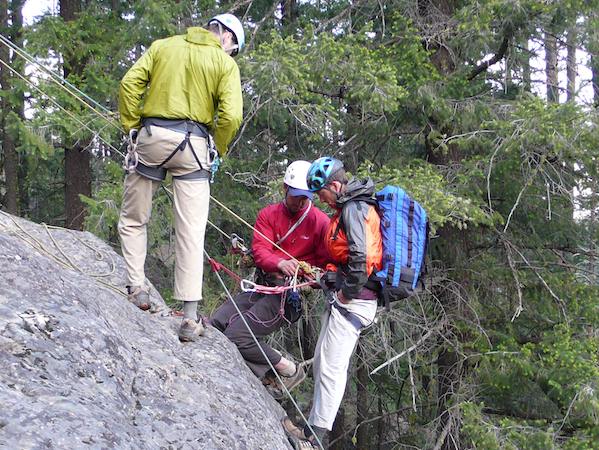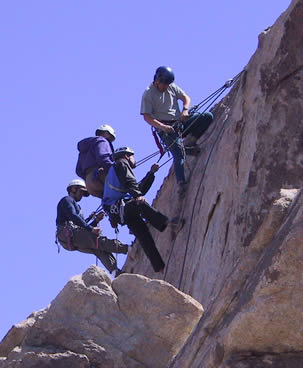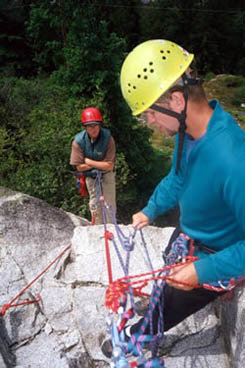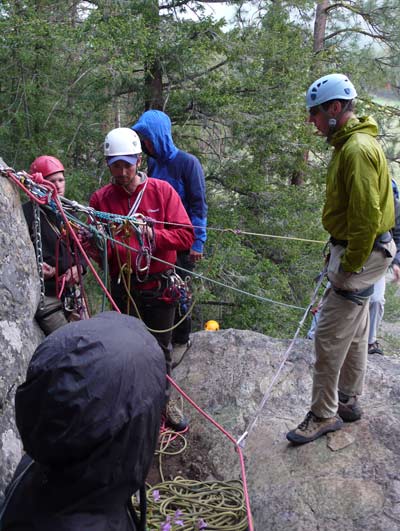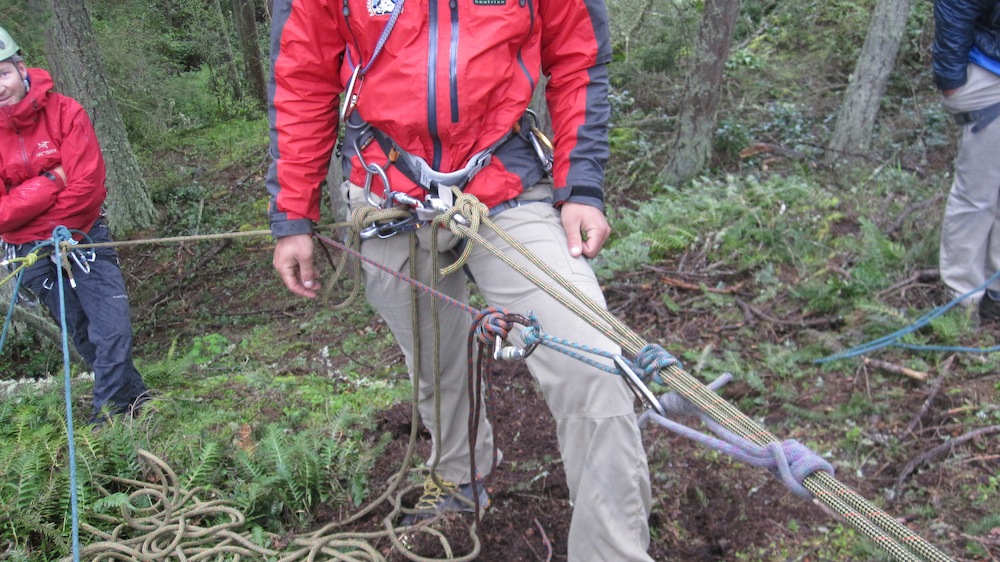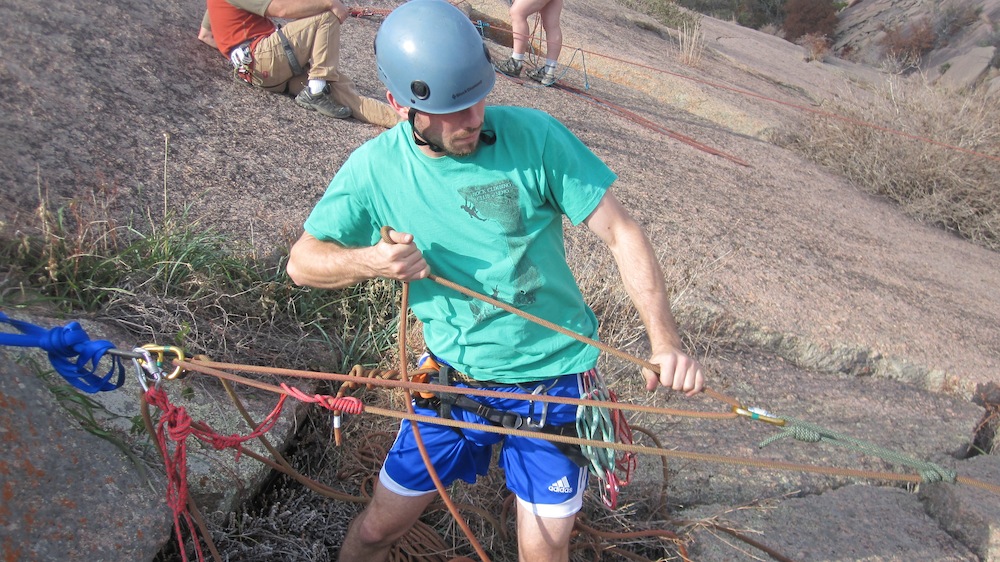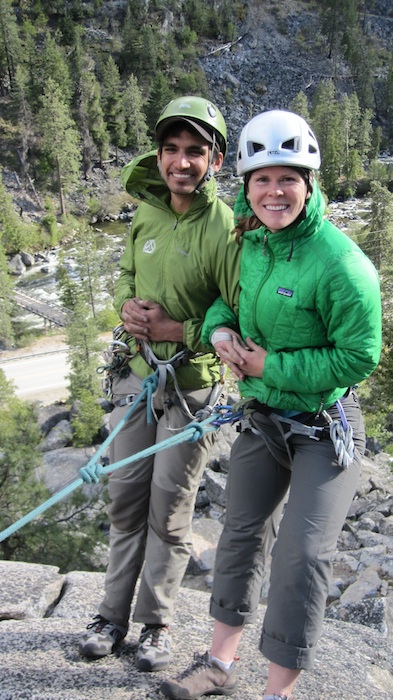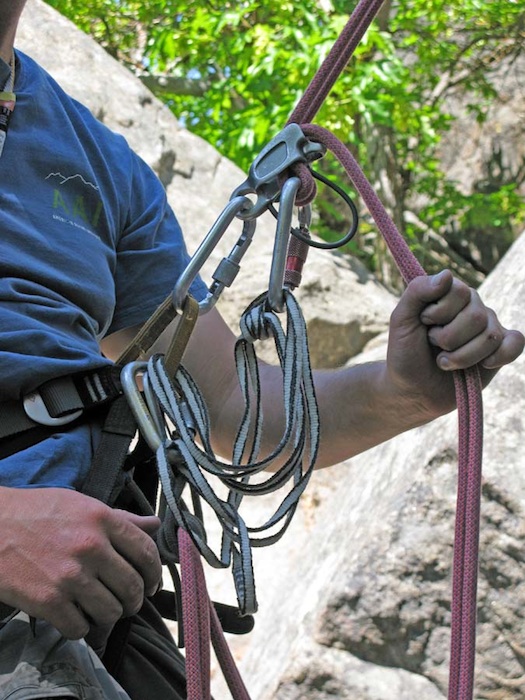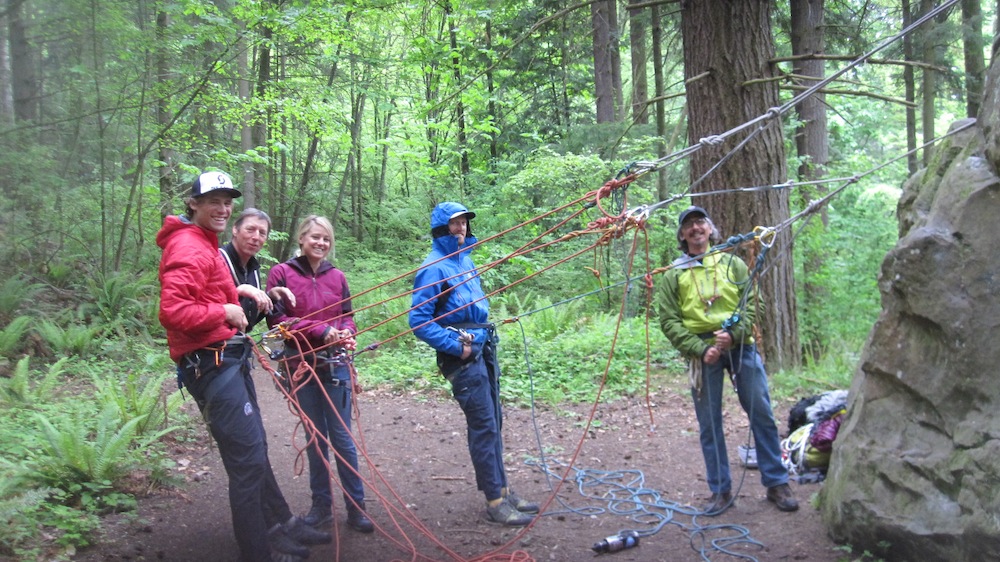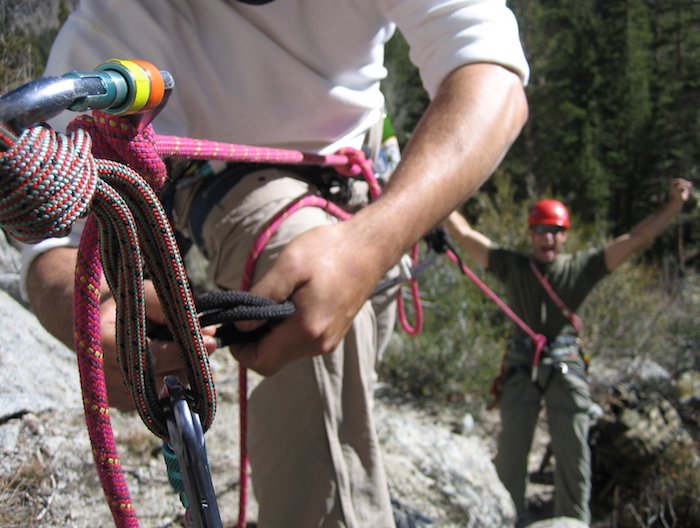Technical Self-Rescue for Climbers Overview
Imagine a rock leader taking a fall and breaking an ankle. You want to lower them, but you don't have enough rope.
Imagine taking a family member out who has never climbed before. They get half-way up a top-rope problem and freeze. They won't climb up or lower down.
Imagine your partner, whipping under a roof that you lead. They can't reach the wall and can't get back on the route. They're stuck.
AAI guides Andrew Yasso and Erin Smart are lowered together on a cow's tail. This technique allows a climber to lower two people at the same time. Jason Martin
Each of the preceding problems could happen to any climber, anytime, anywhere. If you are not prepared to deal with these issues, a minor epic could easily evolve into a full-on situation where somebody gets seriously hurt or dies. Self-rescue is an absolutely essential skill.
Our rescue courses address what you can do with the minimal gear that you normally carry in the mountains. In other words, we want climbers to be able to do most of the things that a Search and Rescue crew might do with a large amount of gear and helicopter support, with nothing more than a rack and a rope.
Rescue skills should be thought of as a spectrum. On one end of the spectrum is the climber who can't pull a move and needs their partner to rig a quick hauling system for assistance. On the other end of the spectrum is the seriously injured climber who needs to be lowered down tricky multi-pitch terrain with a lot of assistance. There is a tremendous amount of material in the entire spectrum of rock rescue and only a small amount of it can be addressed in a two-hour session.
Rock-rescue is a life long learning process. You never know when you will need to use this material and the more knowledge that you have, the better the outcome will be in any real rescue situation.
Technical Self-Rescue for Climbers Curriculum Students will demonstrate improvised rescue proficiency in a wide array of self-rescue and rock-rescue scenarios.
Curriculum Highlights
A climber works a high-end rescue scenario with multiple patients. Michael Powers
Self-Rescue Hauling - 2:1, 3:1, 5:1, 6:1
Pulley Systems
Load Transfers
Lowering Systems - with a munter-hitch, super-munter, tube-style device, and autoblocking device
Anchor Systems
Rope Climbing Techniques - with a friction-hitch system, with an autoblocking device, with an assisted breaking device
Belay Escapes - off an autoblocking device and off the body
Passing Knots
Multi-Pitch Descents with a Patient
Pick-Offs - patient pickoffs for self-rescue
Rappelling - classic rappel, extended rappel, tandem rappel, and counterbalance rappel techniques
Knots - figure-eight family, overhand, double-overhand-on-a-bite, bowline, double bowline, long-tail bowline, butterfly
Bends - double-fisherman's, overhand flat bend, water bend
Hitches - prusik, kliemheist, autoblock, clove, munter, and garda
Load Releasable Hitches - munter-mule
On two-day programs, the first day is spent on the ground, practicing all of the multi-pitch rescue techniques. On the second day, we move into high-angle terrain and repeat the lessons of the previous day with live loads.
Technical Self-Rescue for Climbers Dates The Technical Self-Rescue for Climbers course was designed to be a dynamic course that can be taught almost anywhere. The value is not greater in one place over another. The curriculum is the same in each course location. This course can be combined with Techincal Rope Rescue Comprehensive in Washington.
Group Course Dates
Washington
April 19 - 20, 2025
May 17 - 18, 2025
July 12 - 13, 2025
Oct 04 - 05, 2025
Nov 16 - 17, 2025
Red Rock Canyon, NV
April 4 - 5, 2025
October 18 - 19, 2025
December 6 - 7, 2025
Private Programming
The Technical Self-Rescue for Climbers course may be offered privately in all AAI program areas. Private rates are subject to the program area. Additionally, it may also be possible to offer the course outside of normal program areas. Please contact the AAI office for details.
Some who choose the private programming option prefer to complete one day of training, practice and then come back a month later to complete their second day of training. If an individual puts in a lot of practice time, this can be a very effective way of learning the material. However, if an individual is less inclined to practice, then a two-day program may provide a more effective way of learning.
Private Programming Location Options
Squamish, BC
Bellingham, WA
Mt. Erie, WA
Mazama, WA
Index, WA
Leavenworth, WA
Exit 38, WA
Frenchman Coulee, WA
Bishop, CA
Mammoth, CA
Lee Vining, CA
Joshua Tree National Park, CA
Red Rock Canyon, NV
Technical Self-Rescue for Climbers Details Climbers who are interested in taking the Technical Self-Rescue for Climbers course should have multi-pitch climbing experience prior to enrollment. Private 1-2 day courses are available for climbers of all skill levels, regardless of experience.
Inclusions and Exclusions for Group Courses
Included with the tuition are instructors, group equipment, permit fees, and transportation to and from field program locations. A live Zoom gear consult is also included.
Excluded are front-country lodging, personal climbing equipment, transportation to the meeting place, food, trip insurance, camping equipment, and guide gratuities.
Technical Self-Rescue for Climbers Related Courses
Program Finder
By Location
United States - Alaska
United States - Washington
United States - California
United States - Nevada
United States - Colorado
United States - Utah
Canada - British Columbia
South America - Argentina
South America - Bolivia
South America - Ecuador
South America - Patagonia
South America - Peru
Europe - Alps and Caucasus
Asia - Nepal and Tibet
Asia - Laos, Thailand, & Vietnam
Asia - China
Asia - Japan
Africa - Tanzania
Pacific and Antarctica
By Program Type
Instructional Courses
Group Summit Climbs
Expeditions
Skills Expeditions
Private Guided Programs
Treks, Tours, & Backpacking
Corporate Outings & Services
Government & Military
By Activity
Rock Climbing
Ice Climbing
Alpine Climbing
High-Altitude Climbing
Trekking and Backpacking
Skiing & Snowboarding
Guide Training & Rescue
Avalanche Training
Departure Month
July
August
September
October
November
December
Difficulty Level
Beginner
Moderate
Intermediate
Advanced
Very Advanced
x
